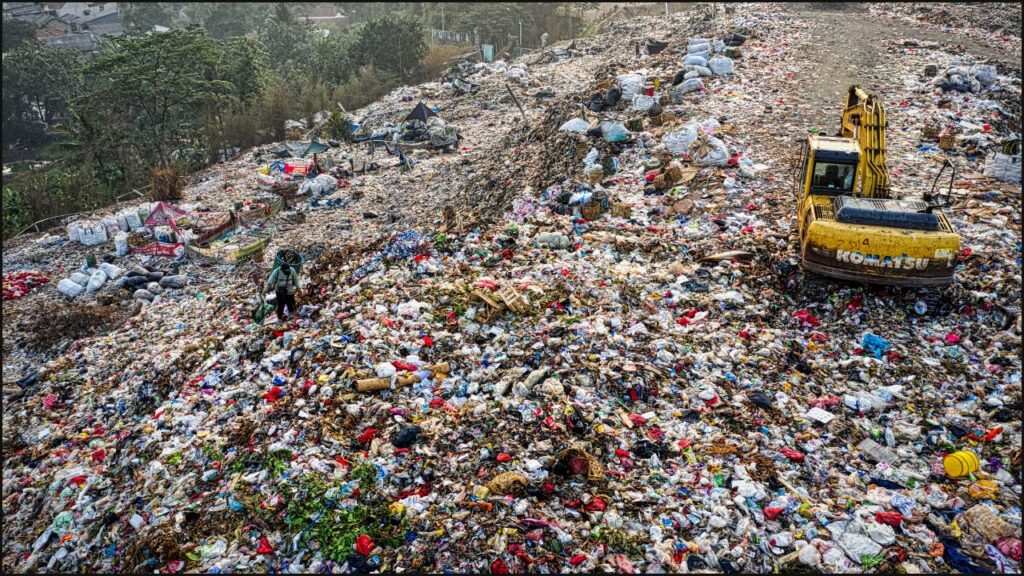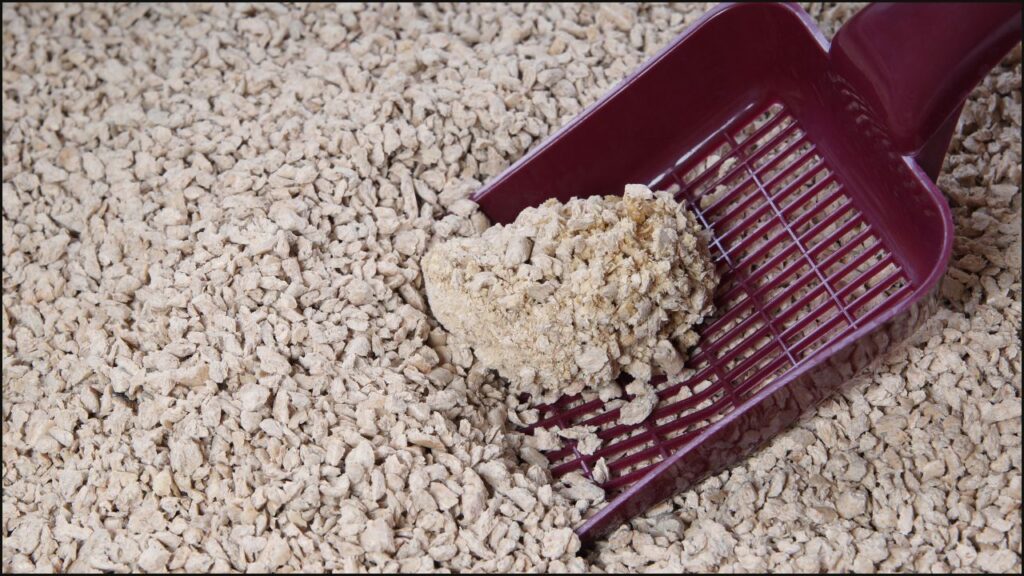Clumping is best.
Cats prefer clean litter boxes, and clumping makes that easy. Natural cat litter with guar gum is better than bentonite clay for health.
The most important thing is to keep your litter box clear of waste with daily cleaning. That makes cats want to use it.
For this article, I researched relevant literature on PubMed, Google Scholar and Science.
In the rest of this article, I’ll go through more about clumping vs non-clumping litter and frequently asked questions.
I recommend seeking the advice of a vet for any further questions. The advice in this article is not intended as medical advice.
Overview of Non-clumping Cat Litter
The first material used for cat litter, was non-clumping Fuller’s earth clay. Called “Kitty Litter” and discovered in the 1940’s, it replaced sand as the litter of choice.
An example of a non-clumping cat litter is wood. This type of litter breaks down into powder and requires a sifting litter tray.
Quick notes:
- Invented in the 1940’s
- Includes wood litter
- Breaks down into powder
Why choose non-clumping cat litter?
Health reasons.
Clumping cat litter is dangerous when eaten. Health problems include:
- Constipation
- Hypokalemia (potassium deficiency)
- Dehydration
- Lethargy
If not treated, ingesting this type of litter can lead to death.
Clumping litter is also not usually biodegradable, whilst non-clumping is flushable.
About 4 billion kilograms of cat litter went to landfills in 2017 – not great for the environment.
Quick notes:
- Healthier
- Safer
- Usually biodegradable

Types of non-clumping cat litter
Options include:
- Corn
- Wheat
- Wood
- Pine
- Recycled paper
Additives like guar gum can make litter clump. This type of additive is also biodegradable if used with these types of litter.
Overview of clumping cat litter
Clumping cat litter came into the market in the 1980’s with the use of sodium bentonite. It is highly absorbable and viscous with urine contact.
That makes solid and easy to remove chunks, which consumers prefer.
Guar gum, among other additives (e.g. psyllium and xanthan gum), are also helpful for clumping.
Quick notes:
- Started in the 1980’s
- Sodium bentonite or additives (e.g. guar gum)
- Easy to remove chunks

Why choose clumping cat litter?
Easy waste disposal.
Cats prefer empty boxes. Research shows feces and urine waste (even when using fake logs) frustrates cats.
It’s also a benefit for cat owners, needing less time and hassle to keep the litter tray clean.
Quick notes:
- Cats prefer empty boxes
- Clumps easy to clean
- Timely
Types of clumping cat litter
Options include:
- Bentonite clay
- Tofu
- Crystal cat litter
Ultimately, the use of additives makes clumping possible in many types of litter. This includes guar gum, psyllium, and xanthan gum.
Other factors to consider when choosing cat litter
Cat Preference
Cats prefer fine grain litter.
In the wild, cats are desert animals using dirt and sand to cover waste. Prior to 1940 and the invention of cat litter, sand was popular.
Most natural litter comes in a pellet shape. Some cats might not enjoy this on the paws (there are fine grain natural litters on the market).
Quick notes:
- Cats prefer small grain litter
- Desert animals
- Test pellets first
Learn more:
- Litter Box Aversion: Solutions for a Clean Home
- What Cat Litter to Do Cats Prefer?
- Scented vs Unscented Cat Litter: What Do Cats Prefer?
Health
Crystal litter contains silica dust, which is carcinogenic and can lead to lung disease. This is a problem in the trades industry, with heavy exposure to dust from tiling and concreting.
One case study revealed a 44 year old woman with lung granulomas. She had 8 cats and 2 litter boxes in her room.
More litter = more risk.
Quick notes:
- Clay contains silica dust
- Carcinogenic
- Avoid use in bedrooms
Learn more:
Biodegradability
Clay doesn’t flush.
Clumping clay litter is similar to material used in cement. This can block pipes if flushed down the toilet.
Things like wood litter with guar gum are flushable types of cat litter. They break down in the environment (check brand).
Quick nots:
- Clumping clay doesn’t flush
- Goes to landfill (~4 billion kg/year)
- Some natural litter flushable
Dust
Nobody likes dust.
Bentonite clay, crystal and wood cat litter dust is hazardous to health. Some litter is dustier than others, but it’s hard to know what’s best without a particle counter.
One study in Thailand showed a lot of variability between brands. Crystal and wood were the dustiest types of litter.
Quick notes:
- Dust is hazardous to health
- Wide variability
- Crystal and wood = dusty
Clumping vs Non-clumping Litter: What’s Best?
Clumping cat litter.
This type of litter is easy to dispose of, which helps you clean the litter box daily. That’s what works best to keep your cat happy.
For health, I’d avoid clay, crystal, and wood litter. Cats prefer small grain litter, so try a natural litter with those characteristics.
Soybean, wheat, and corn litter with guar gum (for clumping) are good options. However, they are risky in humid areas lacking ventilation, since that promotes aflatoxin.
Quick notes:
- Clumping best
- Cats want litter clean
- Consider health effects of chosen litter
Frequently Asked Questions
Can You Mix Clumping and Non-clumping Litter?
Yes.
Although there’s no real reason to do this. The only reason I can think of is when you want to transition cat litter.
Learn more:
How to Clean Non-clumping Litter?
Replace weekly.
You can’t remove urine waste, since it doesn’t clump. Remove feces daily with both clumping and non-clumping litter.
Pine cat litter requires sifting as it dissolves into powder with urine contact.
Why Use Non-clumping Litter for Kittens?
Health and safety.
Kittens are at risk of ingesting clumping litter. This blocks the digestive system, and can lead to nasty health issues (even death).
Where Does the Pee Go With Non-clumping Litter?
Gets absorbed.
Cat litter materials are generally picked for their good absorption. Clumping is a ‘bonus’ that some litter offers.
Is Non-clumping Litter Flushable?
It depends.
Clay bentonite is not flushable since it blocks pipes (it’s basically cement). Biodegradable litter (e.g. wheat) breaks down in the environment (if not put into plastic bags).
Basically – if you put a cat poo in the toilet and flush it, it goes down like any other poo. It’s the other stuff (litter, putting it in a plastic bag) that is problematic.
How Do You Use Non-clumping Pellet Litter?
You use a sifting litter pan.
What works best will depend on the type of litter and size of the pellet.
Conclusion
Clumping cat litter is best.
It’s easier to dispose of waste, to keep the litter tray clean. Cats like that.
Natural cat litter with a biodegradable additive (e.g. guar gum) is the better option. Clumping clay may be harmful to health.
